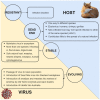An Overview of Anthropogenic Actions as Drivers for Emerging and Re-Emerging Zoonotic Diseases
- PMID: 36422627
- PMCID: PMC9692567
- DOI: 10.3390/pathogens11111376
An Overview of Anthropogenic Actions as Drivers for Emerging and Re-Emerging Zoonotic Diseases
Abstract
Population growth and industrialization have led to a race for greater food and supply productivity. As a result, the occupation and population of forest areas, contact with wildlife and their respective parasites and vectors, the trafficking and consumption of wildlife, the pollution of water sources, and the accumulation of waste occur more frequently. Concurrently, the agricultural and livestock production for human consumption has accelerated, often in a disorderly way, leading to the deforestation of areas that are essential for the planet's climatic and ecological balance. The effects of human actions on other ecosystems such as the marine ecosystem cause equally serious damage, such as the pollution of this habitat, and the reduction of the supply of fish and other animals, causing the coastal population to move to the continent. The sum of these factors leads to an increase in the demands such as housing, basic sanitation, and medical assistance, making these populations underserved and vulnerable to the effects of global warming and to the emergence of emerging and re-emerging diseases. In this article, we discuss the anthropic actions such as climate changes, urbanization, deforestation, the trafficking and eating of wild animals, as well as unsustainable agricultural intensification which are drivers for emerging and re-emerging of zoonotic pathogens such as viral (Ebola virus, hantaviruses, Hendravirus, Nipah virus, rabies, and severe acute respiratory syndrome coronavirus disease-2), bacterial (leptospirosis, Lyme borreliosis, and tuberculosis), parasitic (leishmaniasis) and fungal pathogens, which pose a substantial threat to the global community. Finally, we shed light on the urgent demand for the implementation of the One Health concept as a collaborative global approach to raise awareness and educate people about the science behind and the battle against zoonotic pathogens to mitigate the threat for both humans and animals.
Keywords: COVID-19; Hendra virus; anthropic actions; climatic changes; emerging diseases; hantavirus; leptospirosis; rabies; tuberculosis; zoonoses.
Conflict of interest statement
The authors declare no conflict of interest.
Figures



References
-
- Acha P.N., Szyfres B. Zoonoses and Communicable Diseases Common to Man and Animals. 3rd ed. Volume 1. OIE; Paris, France: 2005. Preface of the first English edition; p. ix.
-
- WHO . Anticipating Emerging Infectious Disease Epidemics. WHO; Geneva, Switzerland: 2015. [(accessed on 1 August 2022)]. Meeting Report. Available online: https://apps.who.int/iris/bitstream/handle/10665/252646/WHO-OHE-PED-2016....
-
- Adhikari S.P., Meng S., Wu Y., Mao Y., Ye R., Wang Q., Sun C., Sylvia S., Rozelle S., Raat H., et al. Epidemiology, causes, clinical manifestation and diagnosis, prevention, and control of coronavirus disease (COVID-19) during the early outbreak period: A scoping review. Infect. Dis. Poverty. 2020;9:1–12. doi: 10.1186/s40249-020-00646-x. - DOI - PMC - PubMed
Publication types
LinkOut - more resources
Full Text Sources
Research Materials

